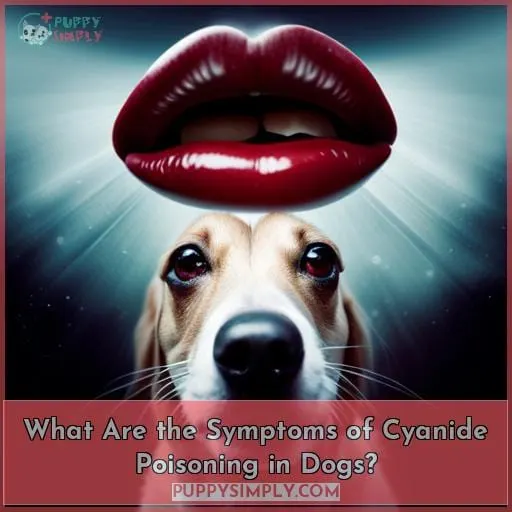This site is supported by our readers. We may earn a commission, at no cost to you, if you purchase through links.
 You should not let your dog eat cherry pits. Cherry pits can pose serious health risks to dogs, like cyanide poisoning and intestinal blockages. The pits contain a compound that can release cyanide when digested, which is toxic to dogs. Additionally, the pits can get stuck in your dog’s digestive tract and cause a dangerous blockage.
You should not let your dog eat cherry pits. Cherry pits can pose serious health risks to dogs, like cyanide poisoning and intestinal blockages. The pits contain a compound that can release cyanide when digested, which is toxic to dogs. Additionally, the pits can get stuck in your dog’s digestive tract and cause a dangerous blockage.
While cherries themselves are safe for dogs in moderation, it’s best to avoid letting them have any access to the pits. If you want to learn more about the specific dangers and safer alternatives, keep reading.
Table Of Contents
- Key Takeaways
- Can Dogs Eat Cherry Pits?
- What Are the Health Risks of Eating Cherry Pits?
- Is It Safe to Feed Dogs Cherries With Pits?
- What Are the Symptoms of Cyanide Poisoning in Dogs?
- What Should I Do if My Dog Has Eaten a Cherry Pit?
- Are There Safer Alternatives?
- Frequently Asked Questions (FAQs)
- Conclusion
Key Takeaways
- Feeding dogs cherry pits can lead to dangerous digestion issues and cyanide poisoning.
- Immediate veterinary assessment and treatment is necessary if a dog ingests cherry pit fragments.
- Eating too many cherry pits can cause intestinal blockage in dogs.
- Safer alternatives to cherries for dogs include apples, carrots, and cucumbers.
Can Dogs Eat Cherry Pits?
You may be wondering if your beloved pet can enjoy the delightful taste of cherries – pits and all! Unfortunately, it’s not recommended for dogs to consume cherry pits due to their potential risks.
Eating cherry pits could potentially lead to dangerous digestion issues such as intestinal blockages or even cyanide poisoning. If you suspect that your dog has ingested a large amount of cherry pit fragments, they should be taken immediately to a veterinarian for an assessment and treatment plan.
When considering giving treats like cherries with the pit still in them, it’s important to understand both sides of fruit fuss: safety versus pleasure. While some pets may find these foods delicious enough to tempt them into eating something potentially hazardous, it’s up to us humans as owners and caregivers to make sure our animals steer clear from any toxic treats that could cause long-term harm to their health.
To ensure best practices when handling food with edible seeds/pits, always consult an expert on pet nutrition before feeding anything new within reason. This includes consulting online resources like Pet Expertise’s page on eating ethics or speaking directly with a vet about which types are safe (or unsafe).
What Are the Health Risks of Eating Cherry Pits?
You may be aware that cherry pits contain cyanide, which when ingested can lead to serious health issues such as cyanide poisoning and intestinal blockage. It is important to understand the potential risks associated with eating cherry pits in order to protect your pet from any long-term harm.
Therefore, it is best practice for owners and caregivers of pets to consult an expert on pet nutrition before feeding anything new – especially foods with edible seeds or pits.
Cyanide Poisoning
Cyanide poisoning can be a serious risk for your pet if they ingest too many cherry pits, so it’s important to be aware of the dangers and take precautions.
Cherry risks include:
- Toxicity symptoms that may appear with bright red gums and difficulty breathing.
- The potential for fatal poisoning if cherry pits are consumed in high enough quantities.
- Poison treatment options available should an animal display cyanide poisoning symptoms.
- Prevention techniques you can use to help keep your furry friend safe from this risk!
Valuable information on these topics is available online or by speaking directly with a vet about which types of food are safe (or unsafe).
Intestinal Blockage
Eating too many cherry pits can cause an intestinal blockage, leading to dangerous gastrointestinal symptoms that could put your furry friend at risk. Depending on the type of cherries consumed (e.g., maraschino versus unprocessed), the size of the pit, and how much is eaten will all play a role in determining if this health risk applies.
Signs of an intestinal blockage typically include vomiting, loss of appetite, lethargy, distended abdomen, and constipation or diarrhea.
Treatment options for pets with gastric problems vary depending on severity. But prevention strategies like limiting treats with small pits, such as blueberries, are key for keeping them safe from these risks.
It’s also important to follow proper feeding guidelines designed by vets or nutritionists.
Is It Safe to Feed Dogs Cherries With Pits?
When it comes to feeding dogs cherries with pits, the answer is generally no. Eating habits aside, there are a number of potential food safety risks associated with this practice that should be considered before doing so.
For starters, cherry pits can cause choking hazards and in some cases lead to intestinal obstruction if ingested by your pet. Additionally, they may also trigger mild digestive issues due to the presence of cyanide, which, when consumed, can lead to serious health concerns such as cyanide poisoning over time – something that Purina nutritionist Karina Carbo-Johnson warns owners about on her website.
While fresh cherries without their pit make for a good treat option for pups from an occasional standpoint, introducing them regularly into your dog’s diet isn’t recommended due to its potentially hazardous effects.
To keep pets safe from any long-term harm:
- Consult an expert on pet nutrition before adding new foods – especially those containing edible seeds or pits – into their diets
- Avoid feeding dogs cherries with pits altogether
- Opt instead for fresh cherry treats (without any added sugar) once in a while
- Monitor closely if you do feed them anything new and look out for signs of discomfort or distress
- Be aware of the potential consequences associated with ingesting small objects like cherry stones
What Are the Symptoms of Cyanide Poisoning in Dogs?
If your pet ingests something containing cyanide, it’s important to be aware of the potential symptoms that may arise. Common signs of cyanide poisoning in dogs include vomiting, lethargy, rapid breathing, and heart rate, and dilated pupils.
Other possible effects include loss of appetite or thirst changes, such as excessive drinking or urinating more often than usual.
For prevention strategies when it comes to cherry pits: always consult an expert on pet nutrition before adding new foods into their diets; avoid feeding them cherries with pits altogether; opt instead for fresh cherry treats (without any added sugar) once in a while; monitor closely if you do feed them anything new and look out for signs of discomfort or distress; be aware that ingesting small objects like cherry stones can come with potentially hazardous consequences, including toxicity from the trace amounts present in certain cherry sources like seeds/pits, which could eventually put your pup’s health at risk! Lastly, make sure the pop-up blocker is enabled so unexpected windows don’t appear asking, Can Dogs Eat Cherry Pits?
What Should I Do if My Dog Has Eaten a Cherry Pit?
If you think your pup has eaten a single cherry pit, the most important thing to do is call your veterinarian immediately. The main danger of cherries is that they contain trace amounts of cyanide in their pits, which can be toxic if ingested by pets.
It’s best to take extreme caution with these fruits and opt for fresh treats without any added sugar instead.
In case of ingestion, some home remedies such as giving dogs food or providing digestive aid may help prevent further complications from occurring—however, this should only be done after consulting a vet first! If left untreated, symptoms like vomiting and lethargy could arise, leading to more severe issues such as seizures or coma.
Due to the risk involved when it comes to consuming cherries (even in small quantities), extra precaution needs to be taken with smaller dogs who are more prone to ingesting objects due to their size relative to the amount consumed at once compared to larger ones eating an entire fruit.
While whole cherry warning signs must always remain visible so that owners are reminded not to let their furry friends eat them unsupervised! Taking preventive measures like making sure all windows have pop-up blockers enabled will also go a long way towards avoiding potential disasters before they even occur! Additionally, veterinary care might be required depending on the severity of the situation where professional advice is needed in order to ensure the safety of the pet’s health and future incidents involving the consumption of forbidden food items are avoided altogether.
Are There Safer Alternatives?
You owe it to your beloved furry friend to provide them with safe and healthy treats instead of the potentially dangerous cherries. Making smart choices when it comes to pet nutrition is key, as certain types of fruits can be toxic if ingested by animals.
Consider natural snacks such as apples, carrots, or cucumbers that are free from added sugar and plant toxicity for a healthier alternative.
Additionally, traditional dog treats like jerky or biscuits should also be considered when looking for ways to reward your pup! When selecting snacks for pets, weighing out the pros & cons of different types of cherries will help you stay on the right path towards sound nutrition habits – so take some time before making any decisions in order to keep your four-legged best friend safe at all times!
Nutritious food options combined with proper research into plant toxicity levels are essential components that come together when creating a balanced diet plan tailored specifically towards canine health needs – so make sure you always have both elements in mind before deciding what type of snack might be best suited for their palates!
Frequently Asked Questions (FAQs)
How many cherry pits can a dog safely eat?
A dog’s digestive system is delicate, so it can only safely consume a few cherry pits. Imagine a cup of cherries; beyond this, your pup could end up with an uncomfortable stomach ache or worse.
How long does it take for cyanide poisoning to manifest in a dog?
Symptoms of cyanide poisoning in dogs can manifest within minutes to hours after ingestion. Signs include difficulty breathing, bright red mucous membranes, dilated pupils, and collapse. Seek veterinary attention immediately if you suspect your dog has ingested a cherry pit or any other source of cyanide.
Are there any benefits to feeding my dog cherries with pits?
Feeding your pup cherries with pits can be beneficial as the pits contain a range of minerals, such as iron, magnesium, and zinc. However, always ensure that they are pitted before being fed to your pet for their safety.
Moreover, eating too many may cause an upset stomach or diarrhea in dogs due to the high sugar content.
Is it safe to give my dog cooked cherries with pits?
It is generally considered safe to give your dog cooked cherries with pits, but it’s important to ensure the pits have been removed. Feeding cherries in moderation can provide beneficial antioxidants and fiber, but watch for any adverse reactions before offering more.
Are there any other fruits or vegetables that contain cyanide?
Are other fruits and vegetables toxic as well? Apples, peaches, and almonds all contain a compound called cyanide. It’s advisable to refrain from giving your dog any of these foods as they can be poisonous.
Conclusion
In conclusion, it’s not safe to feed dogs cherries with pits. Cyanide poisoning is a real risk for dogs, and the symptoms to look out for can be severe. It’s especially important to be aware of this health risk because dogs only need to consume 0.
If you think your dog has eaten a cherry pit, it’s important to act quickly and seek veterinary advice. There are alternatives to feeding your dog cherries with pits, such as removing the pits prior to feeding or feeding your dog cherries without pits.
Keeping these alternatives in mind can help ensure that your dog stays healthy and safe.











